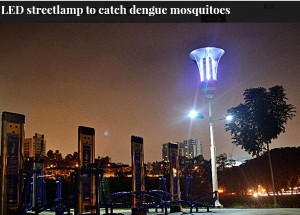Scientists from the University of Malaysia might have finally found a way to stop the spread of the deadly dengue fever plaguing millions in Southeast Asia, the Africa and swathes of South America – a street lamp that pretends to be a human being to lure and trap mosquitoes.
The invention is an LED street lamp that produces low levels of carbon dioxide by combining ultraviolet light with titanium dioxide to emulate the smell of a human being. The mosquitoes are attracted to the smell and enter capture windows in the upper part of the lamp, where they are then sucked in a capture net in the lamp by a fan.tips dan trik android
To make it green and energy efficient, the Eco-Greenery outdoor lighting system is designed to harness electricity from wind and solar energy, to off-set the tiny amounts of carbon emissions needed to trap the mosquitoes, and the lamp is also designed to continue working in flood situations, while alerting search and rescue centres to dangerous water levels.
Dengue fever is a mosquito-borne viral infection that causes a severe flu-like illness and flourishes in a tropical climate. Like pneumonia, it can be overcome, but it can also develop into a potentially lethal complication as there is no specific treatment.
The World Health Organization says that currently 2.5 billion people (40% of the world’s total population) live in areas where dengue can be transmitted, with 50-100 million new infections occurring annually in 100 countries, and an annual death toll of 20,000, which is about 2.5% of the total number of people infected.
The disease is spread by the Aedes aegypti mosquito biting and sucking the blood of a person who has already been infected by the dengue virus. Symptoms include fever, headache, vomiting, muscle and joint pains.
The Aedes mosquito is also the same species spreading the Zika virus in Central and South America that causesGuillain-Barré syndrome − a nerve disorder where patients experience temporary muscle paralysis, that can also cause babies to be born with underdeveloped brains and small heads.
Even more worryingly, while there were only nine countries in the world where dengue occurred prior to 1970, in the last 50 years the number of cases has increased 30 fold and the infection has now reached epidemic status, and there is a change it will soon spread across Europe since dengue cases were reported for the first time ever in France and Croatia in 2010.
As a vaccine for dengue fever has yet to be found, currently the disease costs up to $2bn a year to pay for prevention methods, including the most effective, which is widespread chemical fogging.
Source:
March 2, 2016 18:02 GMT
